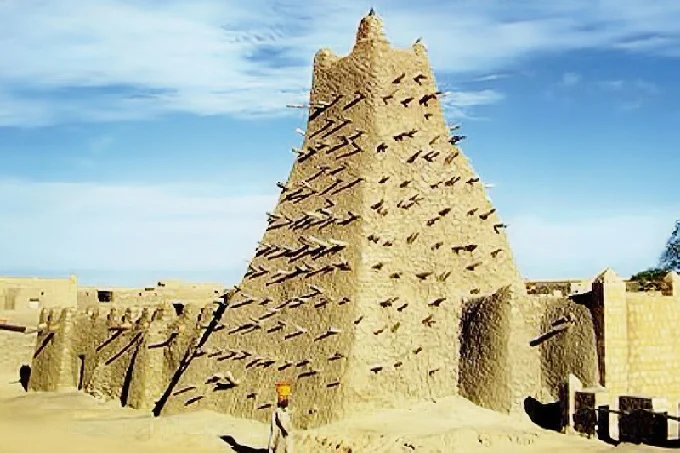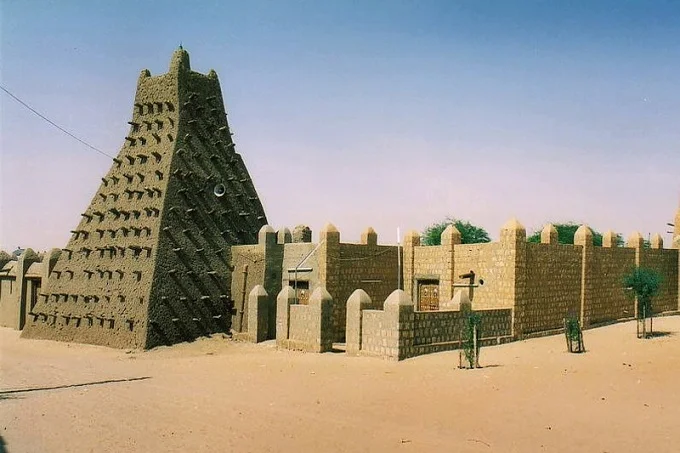Timbuktu: the city of eternal dreams

No one knows in what darkness of centuries this city appeared, sprawled at the very southern edge of the great Sahara, which long ago became an elusive dream and an eternal grave for generations of travelers. Its name is Timbuktu.
The legends say that its streets are lined with golden slabs, that 333 Great Magicians live there, owning treasures whose value exceeds the despicable metal. These are manuscripts in which the secrets of existence are revealed, and there are answers to all the questions that humanity may have.
The price of desires
Europeans first heard about this wonderful city in the XII century – from Arab travelers. Hundreds of adventurers poured in search of the African El Dorado. But neither the mask of a black tan nor the rags of local rags could hide the greedy gleam of their eyes. So the “Guardians of the Golden Chariot road” Garamant warriors-magicians, without ceremony, stuck a knife into the throat of greedy strangers, strangled them with a whip, and then immured them in clay walls, using skeletons for formwork. For five hundred years, Timbuktu remained a sweet legend for Europeans!
Englishman Alexander Gordon Lang was the first to reach the cherished city. From the age of 16, serving in the British army that occupied Sierra Leone, he had heard a lot about gold caravans, and was eager to find Timbuktu.

In 1825, Lang led an expeditionary force. The Briton paid dearly for his dream! For a whole year, he and his men broke through the sands of the Sahara and turned out to be the only ones who survived the battles with the Garamant tribes.
Having received three saber blows to the head, a bullet in the thigh, a knife in the neck and back, he still achieved his goal. What he was doing in Timbuktu, where he was hiding, remains a mystery. Joining a trading caravan, he tried to return home, but on the way back, he was killed.
French adventurer Rene Kaye entered Timbuktu disguised as an Arab a few years later. But he was immediately exposed and immured with a knife in the rib in the fence of the mosque.
The most successful turned out to be Heinrich Barth, who prepared for a dangerous expedition with true German pedantry: he learned to speak Arabic without an accent, mastered not only the art of dressing like locals but even eating and making love, as is customary in those parts. Remaining unrecognized, Bart lived in Timbuktu for several years, compiling an account of his journey. In this report, Timbuktu appears as a dusty, impoverished town, half-buried in the sand.
How so? Why have Arab travelers for centuries described it as the center of fabulous wealth and great intelligence, while Europeans saw only dust and desolation? What is this mysterious Timbuktu really like?

Ghost Town
It has been a long time since travelers who set their footsteps in Timbuktu have not been killed or persecuted. For ten days, they rafted along the great African river Niger from the capital of Mali – Bamako towards Timbuktu Bay.
The legendary city really turned out to be gray and uncomfortable. Not gold, but sand lined its deserted streets with a solid carpet. Right in the air, here and there, large conical-shaped clay ovens are smoking, in which the mistresses, wrapped up to the eyes, bake unleavened tortillas. The only decoration of the city turned out to be two mosques, which were erected in 1325 by a pilgrim from Morocco, Kanhan Moussa. Time is constantly destroying them, but there is a lot of clay here, and the restoration of these bizarre stucco structures has been going on methodically for centuries, not stopping for a single day. That’s all the values of Timbuktu?
In search of the truth
Full of disappointment, they wandered through the narrow dusty streets of this, in fact, a large village and were unspeakably glad when the local “Tuaregs” offered to go on an excursion to their camp located nearby.
There are very few true Tuaregs left in the Sahara. They live separately in the hidden corners of the desert, avoiding meetings with foreigners. There are no Tuaregs in Timbuktu. But there is a demand for them. In lively places, where there are many tourists, there are camps of the Bella, Iullemeden, Berbers, and others who willingly portray Tuaregs.

They got into the Malinke tribe. Once, their ancestors were farmers and hunters of the savannah, now captured by the sands of the Sahara. Farmers have moved away from the south, to where it is still possible to grow durra, cassava, and cotton. But hunters and storytelling singers, who are called griots, remained on the land of their ancestors. So the Griots quite unexpectedly opened the veil over the secret of the hidden city.
…Do you know how the devil took revenge on man for following God and not him? He breathed into the yellow metal a special spell that awakens a pernicious passion for gold. And I was not mistaken: the spell worked. People, as if distraught, began to “die for metal.” That is why the Garamanta warriors-magicians have been so zealously guarding the gold reserve of humanity for thousands of years, hidden where the city of Timbuktu stands. (The Arab traveler Abu Bekr Ahmad al-Hamadani (IX century) reported that in the countries of Ghana and Mali, gold “grows” like carrots and is harvested along the river at sunrise). The stolen gold was buried together with the bodies of those who defiled themselves with an excessive passion for its possession. It is no coincidence that 333 Great teachers who know all the wisdom of the world settled in the place of the concentration of gold. And it is not by chance that the gold that lined the streets of the legendary Timbuktu was trampled under the feet of the sages.
How can the despicable metal compare with the power of the enlightened human spirit?
For many centuries, none of the travelers came to Timbuktu to ask for knowledge. In the end, the Teachers decided to hide the gold from the eyes of greed. For those hungry for material wealth, Timbuktu’s twin was created, a city that everyone can visit, driven by the thirst for profit. But instead of gold, there will be sand under his feet.

When he asked an old griot if it was possible to see the real Timbuktu, he took me to the sacred graves of my ancestors to perform tasauit – a rite of asking for advice. Pushing aside the Shuahed tombstone, dotted with many unknown signs, the narrator told him to lie down in the cold darkness, drink the sorcery potion borbur, and – to give myself into the power of the Altinen spirits of another world. And then we climbed the dune together with him, and in the distance, I saw a magical glow. The gold of Timbuktu’s pavements glowed.
Now I know for sure that when the curse subsides, the legendary city will once again become the only one, delighting humanity that has woken up from the devil’s spell. But only when will it be?




